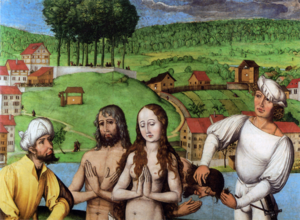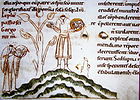
Felix and Regula
Encyclopedia
| Saints Felix and Regula | |
|---|---|
 |
|
| Martyrs | |
| Born | ? |
| Died | 286 AD |
| Venerated in | Roman Catholic Church Roman Catholic Church The Catholic Church, also known as the Roman Catholic Church, is the world's largest Christian church, with over a billion members. Led by the Pope, it defines its mission as spreading the gospel of Jesus Christ, administering the sacraments and exercising charity... , Coptic Orthodox Church |
| Beatified | Pre-Congregation |
| Canonized | Pre-Congregation |
| Major shrine Shrine A shrine is a holy or sacred place, which is dedicated to a specific deity, ancestor, hero, martyr, saint, daemon or similar figure of awe and respect, at which they are venerated or worshipped. Shrines often contain idols, relics, or other such objects associated with the figure being venerated.... |
Zürich |
| Feast Calendar of saints The calendar of saints is a traditional Christian method of organizing a liturgical year by associating each day with one or more saints and referring to the feast day of said saint... |
September 11 |
| Attributes | N/A |
| Patronage | Zürich |


Patron saint
A patron saint is a saint who is regarded as the intercessor and advocate in heaven of a nation, place, craft, activity, class, clan, family, or person...
s of Zürich
Zürich
Zurich is the largest city in Switzerland and the capital of the canton of Zurich. It is located in central Switzerland at the northwestern tip of Lake Zurich...
, their feast day being 11 September at the head of the Coptic Calendar.
Felix and Regula were siblings, and members of the Theban legion
Theban Legion
The Theban Legion figures in Christian hagiography as an entire Roman legion — of "six thousand six hundred and sixty-six men" — who had converted en masse to Christianity and were martyred together, in 286, according to the hagiographies of Saint Maurice, the chief among the Legion's...
under Saint Maurice
Saint Maurice
Saint Maurice was the leader of the legendary Roman Theban Legion in the 3rd century, and one of the favorite and most widely venerated saints of that group. He was the patron saint of several professions, locales, and kingdoms...
, stationed in Agaunum
Agaunum
Roman Agaunum, the modern Saint-Maurice in the canton Valais in southwesternmost Switzerland, was a minor post confined between the Rhône and the mountains along the well-travelled road that led from Roman Genava, modern Geneva, over the Alps by the Great St...
in the Valais
Valais
The Valais is one of the 26 cantons of Switzerland in the southwestern part of the country, around the valley of the Rhône from its headwaters to Lake Geneva, separating the Pennine Alps from the Bernese Alps. The canton is one of the drier parts of Switzerland in its central Rhône valley...
. When the legion was to be executed in 286, they fled, reaching Zürich via Glarus
Glarus
Glarus is the capital of the Canton of Glarus in Switzerland. Glarus municipality since 1 January 2011 incorporates the former municipalities of Ennenda, Netstal and Riedern....
before they were caught, tried and executed. After decapitation
Decapitation
Decapitation is the separation of the head from the body. Beheading typically refers to the act of intentional decapitation, e.g., as a means of murder or execution; it may be accomplished, for example, with an axe, sword, knife, wire, or by other more sophisticated means such as a guillotine...
, they miraculously stood to their feet, picked up their own heads, walked forty paces uphill, and prayed before lying down in death. The cephalophore
Cephalophore
A cephalophore is a saint who is generally depicted carrying his or her own head; in art, this was usually meant to signify that the subject in question had been martyred by beheading....
s were buried on the spot where they lay down.
Accounts of this event also state there were others from the Theban Legion who were beheaded and thrown into the river. Many witnessed these walking up out of the water with their heads in their hands, similar to Felix and Regula.

Grossmünster
The Grossmünster is a Romanesque-style church in Zurich, Switzerland. It is one of the three major churches in the city . The core of the present building near the banks of the Limmat River was constructed on the site of a Carolingian church, which was, according to legend, originally commissioned...
, burial place of Saints Felix and Regula, at the river Limmat
Limmat
The Limmat is a river in Switzerland. It is the continuation of the Linth river, known as Limmat from the point of effluence from Lake Zurich, in the city of Zurich. From Zurich it flows in a northwesterly direction, after 35 km reaching the river Aare...
the Wasserkirche
Wasserkirche
The Wasserkirche of Zürich, first mentioned as ecclesia Aquatica Turicensi around 1250 and as wazzirkilcha in 1256, is a church built on a small island in the Limmat, situated between the two main churches of medieval Zürich, the Grossmünster and the Fraumünster.- Overview :The site was likely...
(Water Church), their execution site, and on the left side of the Limmat the Fraumünster Abbey, where important relics of the saints used to be on display to the public.
The legend cannot be traced beyond an 8th century account, according to which the story was revealed to a monk called Florentius.
In the 9th century there was a small monastery at the location, outside the settlement of Zürich which was situated on the left side of the Limmat
Limmat
The Limmat is a river in Switzerland. It is the continuation of the Linth river, known as Limmat from the point of effluence from Lake Zurich, in the city of Zurich. From Zurich it flows in a northwesterly direction, after 35 km reaching the river Aare...
. The Grossmünster
Grossmünster
The Grossmünster is a Romanesque-style church in Zurich, Switzerland. It is one of the three major churches in the city . The core of the present building near the banks of the Limmat River was constructed on the site of a Carolingian church, which was, according to legend, originally commissioned...
was built on their graves from ca. 1100, while at the site of their execution stands the Wasserkirche
Wasserkirche
The Wasserkirche of Zürich, first mentioned as ecclesia Aquatica Turicensi around 1250 and as wazzirkilcha in 1256, is a church built on a small island in the Limmat, situated between the two main churches of medieval Zürich, the Grossmünster and the Fraumünster.- Overview :The site was likely...
. From the 13th century, images of the saints were used in official seals of the city and on coins. On the saints' feast day, their relics were carried in procession between the Grossmünster and the Fraumünster
Fraumünster
The Fraumünster abbey in Zurich was founded in 853 by Louis the German for his daughter Hildegard. He endowed the Benedictine convent with the lands of Zurich, Uri, and the Albis forest, and granted the convent immunity, placing it under his direct authority.- History :In 1045, King Henry III...
, and the two monasteries vied for possession of the relics, which attracted enough pilgrims to make Zürich the most important pilgrimage site in the bishopric of Konstanz
Konstanz
Konstanz is a university city with approximately 80,000 inhabitants located at the western end of Lake Constance in the south-west corner of Germany, bordering Switzerland. The city houses the University of Konstanz.-Location:...
. The Knabenschiessen
Knabenschiessen
Knabenschiessen is a traditional target shooting competition in Zürich. held on the second weekend of September each year. The festival, officially held for the first time in 1889, is one of the oldest in Switzerland, dating back to the 17th century....
of Zürich originates with the festival.
With the dissolution of the monasteries by Huldrych Zwingli
Huldrych Zwingli
Ulrich Zwingli was a leader of the Reformation in Switzerland. Born during a time of emerging Swiss patriotism and increasing criticism of the Swiss mercenary system, he attended the University of Vienna and the University of Basel, a scholarly centre of humanism...
in 1524, their possessions were confiscated and the graves of the martyrs were opened. There are conflicting versions of what happened then. Heinrich Bullinger
Heinrich Bullinger
Heinrich Bullinger was a Swiss reformer, the successor of Huldrych Zwingli as head of the Zurich church and pastor at Grossmünster...
claims that the graves were empty save for a few bone fragments, which were piously buried in the common graveyard outside the church. The Catholics, on the other hand, claimed that the reformers were planning to throw the relics of the saints into the river, and that a courageous man of Uri
Canton of Uri
Uri is one of the 26 cantons of Switzerland and a founding member of the Swiss Confederation. It is located in Central Switzerland. The canton's territory covers the valley of the Reuss River between Lake Lucerne and the St. Gotthard Pass. German is the primary language spoken in Uri...
(who happened to be exiled from Uri, and by his action earned amnesty
Amnesty
Amnesty is a legislative or executive act by which a state restores those who may have been guilty of an offense against it to the positions of innocent people, without changing the laws defining the offense. It includes more than pardon, in as much as it obliterates all legal remembrance of the...
) stole the relics from the church and carried them to Andermatt
Andermatt
Andermatt is a municipality in the canton of Uri in Switzerland.With Realp and Hospental, it is located in the Urseren valley, south of Altdorf.-Geography:...
, where the two skulls of Felix and Regula can be seen to this day, while the remaining relics were returned to Zürich in 1950, to the newly built Catholic church St. Felix und Regula. The skulls have been Carbon 14 dated, and while one dates to the Middle Ages, the other is in fact composed of fragments of two separate skulls, of which one is medieval, and the other could indeed date to Roman times.
This event largely contributed to the massive conversion of the inhabitants of these regions to Christianity. It had such an impact on Zurich, that these three saints still appear on the coat of arms and seal of Zurich today.
Literature (in German)
- Hansueli Etter, Urs Baur, Jürg Hanser, Jürg Schneider (Hrsg.): Die Zürcher Stadtheiligen Felix und Regula. Legenden, Reliquien, Geschichte und ihre Botschaft im Licht moderner Forschung. Hochbauamt der Stadt Zürich/Büro für Archäologie, Zürich 1988 ISBN 3-90524301-6
- Walter Nigg: Felix und Regula, Aneignung einer Legende. Zürich: SV International, Schweizer Verlagshaus, 1983. ISBN 3726363610
- Jürg Hanser, Armin Mathis, Ulrich Ruoff, Jürg Schneider: Das neue Bild des Alten Zürich. Zürich 1983
- Cécile Ramer, Felix, Regula und Exuperantius; Ikonographie der Stifts- und Stadtheiligen Zürichs. Zürich: Antiquarische Gesellschaft, 1973.
External links
- CPG 111, 1470s manuscript containing the legend of Felix and Regula as well as that of Saint Meinrad.
- University of Zürich: «Die Stadt Zürich und ihre Märtyrer – ein multimedialer Pfad»
- Orthodox Vesper in honor of St. Felix, St. Regula and St. Exuperantius

